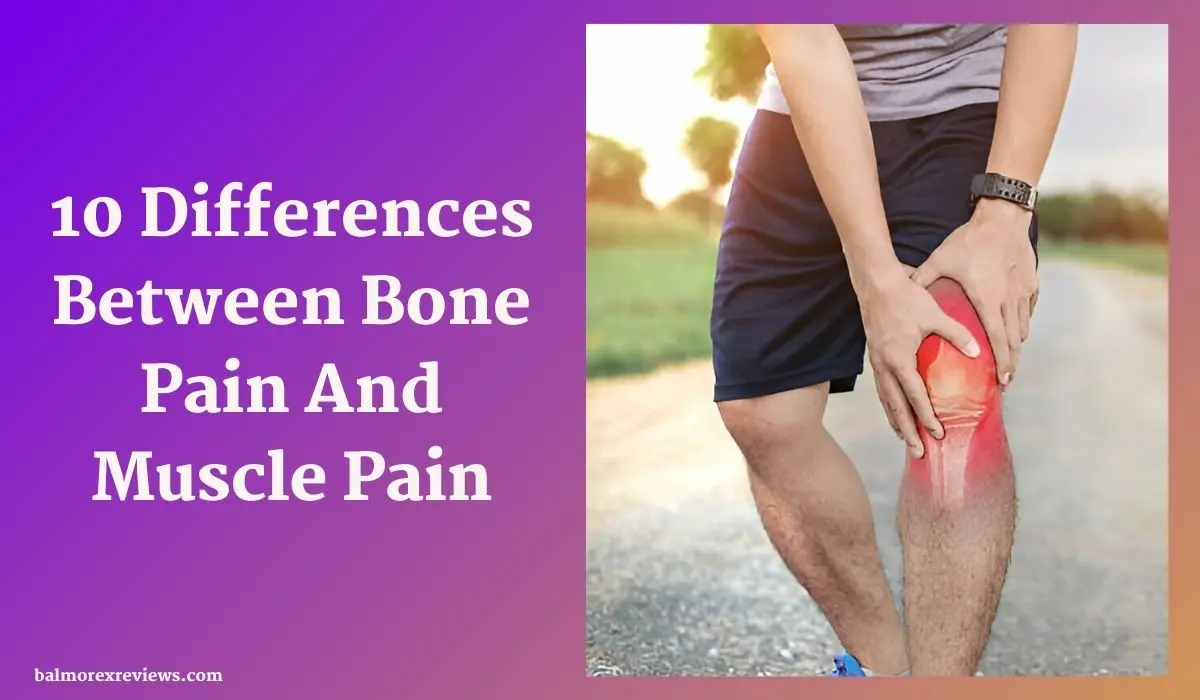10 Differences Between Bone Pain And Muscle Pain
Uncover the nuances between bone pain and muscle pain with our insightful guide. Delve into the ten key distinctions to better understand the origin, symptoms, and treatment options for each type of discomfort. Whether you’re experiencing aches from injury, overuse, or underlying conditions, this comprehensive comparison will empower you to identify and address your pain effectively. Gain clarity and confidence in managing bone and muscle pain with our expert insights.

Disclaimer: This article has been generated with the assistance of AI tools. While our research team has fact-checked the content, readers should independently verify information for accuracy and reliability.
When faced with discomfort or pain in our bodies, it can be challenging to pinpoint the source – is it originating from the bones or the muscles? While both bone pain and muscle pain can be distressing, they have distinct characteristics and underlying causes. Understanding the differences between these two types of pain is crucial for obtaining an accurate diagnosis and receiving appropriate treatment.
In this article, we will explore 10 key distinctions that can help you differentiate between bone pain and muscle pain.

1. Location: Pinpointed vs. Widespread
Bone pain is typically localized and felt in a specific area, such as a joint or a particular bone. For example, if you have a fracture in your wrist, the pain will be concentrated around that area. In contrast, muscle pain can be more widespread and felt across a larger or multiple muscle group. A strained hamstring, for instance, may cause pain throughout the back of the thigh and potentially extend to the knee or lower back.
2. Pain Characteristics: Dull vs. Throbbing
Bone pain is often described as a deep, dull, and constant ache that can range from mild to severe. It may feel like a persistent, gnawing sensation that doesn’t subside easily. Muscle pain, on the other hand, is usually characterized as a dull, throbbing, or aching sensation that may intensify with movement or activity. The pain can also be described as a cramping or pulling sensation within the affected muscle.
3. Onset: Gradual or Sudden vs. Gradual
Bone pain can develop gradually or suddenly, depending on the underlying cause. For example, a stress fracture may start as a mild ache and progressively worsen over time, while a traumatic fracture can cause immediate, severe pain. Muscle pain typically has a more gradual onset and may worsen with activity or overuse. It often starts as a mild discomfort and escalates if the strain or overuse continues.
Related: Aloe Vera For Knee Pain Relief: Nature’s Soothing Solution
4. Underlying Causes: Bones vs. Muscles
Bone pain can result from a variety of conditions, including fractures, osteoporosis, arthritis, bone infections, or bone cancer. These conditions can affect the structural integrity or density of the bones, leading to pain. Muscle pain, on the other hand, is commonly caused by overuse, strains, sprains, or underlying medical conditions like fibromyalgia or myositis, which involve inflammation or dysfunction of the muscles.
5. Swelling: Less Common vs. More Common
While both bone and muscle pain can be accompanied by swelling, it is more common with muscle injuries or inflammation. When a muscle is strained or overworked, it can lead to localized swelling and inflammation as the body attempts to repair the damaged tissue. Bone pain may also cause some swelling, but it is generally less pronounced than in cases of muscle injury.
6. Tenderness: Localized vs. Diffuse
Bone pain is often accompanied by tenderness or sensitivity to touch in the affected area. For example, if you have a fracture in your arm, the area around the fracture site will be extremely tender and painful to the touch. Muscle pain may also involve tenderness, but it is typically more diffuse and may extend beyond the immediate area of injury or strain.
Related: How To Choose The Best Muscle Pain Relief Cream? A Guide!
7. Impact Of Movement: Exacerbated vs. Relieved
Bone pain can be exacerbated by movement or weight-bearing activities, as these actions put additional stress on the affected bone. For example, walking or standing for prolonged periods may worsen the pain from a stress fracture in the foot or leg. In contrast, muscle pain may be relieved by gentle stretching or massage, as these activities can help relax and loosen the tight or strained muscle fibers.
8. Pain Radiation: Can Radiate vs. Localized
Bone pain can sometimes radiate or travel to other areas, particularly if it’s caused by a condition like a herniated disc or nerve compression. For instance, a herniated disc in the lower back may cause pain that radiates down the leg along the path of the affected nerve. Muscle pain, however, typically remains localized to the affected muscle group or the immediate area surrounding it.
9. Night Pain: More Severe vs. Less Common
Bone pain, especially from conditions like arthritis or bone cancer, can be more severe at night or when resting. This is because the lack of activity and movement can allow inflammation or pressure to build up in the affected area. Muscle pain may also be present at night, but it’s less common, as the muscles are generally resting and not under strain or exertion.
Related: How To Get Rid Of Muscle Discomfort In Legs: Tips And Techniques
10. Associated Symptoms: Systemic vs. Local
Bone pain can be accompanied by a range of associated symptoms, depending on the underlying condition. For example, bone cancer may cause fatigue, night sweats, or unexplained weight loss. Arthritis can lead to stiffness, joint swelling, and reduced mobility. Muscle pain, on the other hand, may be accompanied by stiffness, cramping, or weakness in the affected muscle group, but it rarely causes systemic symptoms unless there is an underlying medical condition. Try Balmorex Pro cream for muscle and joint pain.
Bottom Line
Understanding the nuances between bone pain and muscle pain can help you communicate your symptoms more effectively to your healthcare provider and receive the appropriate treatment. If you experience persistent or severe pain, it’s crucial to consult a medical professional for proper evaluation and management.
In some cases, the distinction between bone pain and muscle pain may not be immediately apparent, as certain conditions can involve both types of pain simultaneously. For example, fibromyalgia can cause widespread muscle pain, but it can also lead to generalized bone and joint pain. Additionally, some conditions, like arthritis or injuries involving both bones and surrounding muscles, may present with a combination of bone and muscle pain.
Diagnostic tests, such as X-rays, MRI scans, or blood tests, may be necessary to identify the underlying cause and determine the most appropriate course of treatment. By paying attention to the specific characteristics of your pain, as well as any accompanying symptoms, and providing your healthcare provider with a detailed description, you can take an active role in your healthcare journey and work collaboratively to find relief and address the root cause of your discomfort.
Remember, while pain can be a frustrating and debilitating experience, proper diagnosis and management can significantly improve your quality of life. By understanding the differences between bone pain and muscle pain, you can take the first step toward finding the appropriate solution for your discomfort.
Natalie Smith
Natalie Smith is a highly respected Osteopath with over 15 years of experience in treating a wide range of musculoskeletal conditions. She graduated from the British School of Osteopathy with a Master’s degree in Osteopathic Medicine and is a registered member of the General Osteopathic Council. Natalie’s expertise spans the diagnosis and treatment of issues affecting the muscles, bones, joints, and connective tissues. She utilizes a holistic, patient-centered approach, combining manual techniques such as spinal manipulation, soft tissue massage, and joint mobilization to alleviate pain and restore optimal function. Passionate about educating her patients, Natalie frequently speaks at local health workshops and has authored articles on osteopathic care for several respected medical journals. Her commitment to ongoing professional development ensures she remains at the forefront of the latest advancements in the field of osteopathy.
